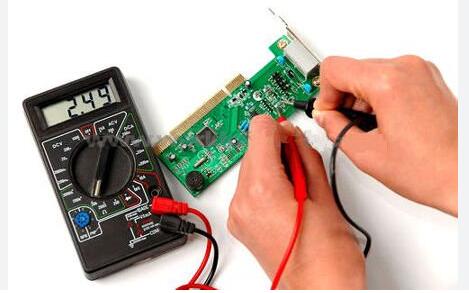Circuit boards are an indispensable part of modern electronic equipment, and the quality and status of their constituent components directly affect the working effect and stability of circuit boards. Therefore, detecting the quality and status of circuit board components is particularly important.

1. Resistance detection
Resistors are a common electronic component whose main function is to provide resistance for circuits such as current limiting, voltage dividing, filtering, and voltage regulation. The closer the resistance value of the resistor is to the nominal value, the better its quality. Therefore, in circuit design and manufacturing, it is necessary to detect resistors.
1) DC bridge method
The DC bridge method is a commonly used resistor detection method, which uses a circuit called a bridge to measure the resistance value of the resistor by adjusting the resistance value in the bridge circuit to make the potential difference between the two ends of the bridge zero. The DC bridge method has high accuracy in detecting resistors and is suitable for resistors with small resistance values and high accuracy requirements.
2) Multimeter method
The multimeter method is a simple and easy to use resistor detection method, which only requires the use of a multimeter to directly measure the resistance value of the resistor. This method is simple and feasible, suitable for resistor detection in general circuits, but its accuracy is not as good as the DC bridge method.
3) Laser detection method
The laser detection method is a high-precision and high-speed resistor detection method, which uses a laser interferometer to measure the length and cross-sectional area of the resistor and calculate its resistance value. This method has high accuracy and is suitable for rapid detection of large quantities of resistors.
2. Detection of capacitance
A capacitor is a device that stores charges, and its main function is to provide filtering, coupling, and isolation functions in a circuit. In circuit design and manufacturing, capacitors need to be tested to ensure that their capacitance and withstand voltage meet the requirements.
1) Bridge detection method
The bridge detection method is a commonly used capacitor detection method, which uses a circuit called a capacitor bridge to measure the capacitance of a capacitor by adjusting the capacitance value in the bridge circuit to make the potential difference between the two ends of the bridge zero. This method is suitable for capacitor detection with small capacitance values and high accuracy requirements.
2) Oscilloscope method
The oscilloscope method is an intuitive and easy-to-use capacitor detection method, which uses an oscilloscope to display the waveform during the charging and discharging process of the capacitor, thereby measuring the capacitance value of the capacitor. This method is suitable for capacitor detection with large capacitance and low accuracy requirements.
3. Diode testing
Diodes are a common electronic component whose main function is to limit the current in a circuit in one direction, used in circuits such as rectification, amplification, and protection. In circuit design and manufacturing, it is necessary to detect diodes to ensure that their forward and reverse connections and conduction performance meet the requirements.
1) Multimeter method
The multimeter method is a simple and easy diode detection method, which only requires the use of a multimeter to directly measure the positive and negative voltage and conduction current of the diode. This method is suitable for diode detection in general circuits, but cannot detect the special performance of diodes, such as response time and noise.
2) Dynamic resistance method
The dynamic resistance method is a commonly used diode detection method, which measures the dynamic resistance value of the diode under forward voltage by applying a certain forward voltage and DC, to determine its conductivity and quality. This method is suitable for rapid detection of large quantities of diodes, but cannot detect performance such as reverse voltage and reverse leakage current.
3) Cold and hot testing methods
The hot and cold testing method is a comprehensive diode detection method, which is based on conducting electrical performance tests at a constant temperature to determine the performance of diodes, such as forward and reverse voltage, reverse leakage current, conduction current, and response time. This method is suitable for comprehensive performance testing of large batches of diodes but requires specialized testing equipment and environment.
4. Detection of transistors
Transistors are an important electronic component whose main function is to amplify and control current in circuits.
1) Static parameter testing method
The static parameter testing method is a commonly used transistor detection method. Its principle is to measure the static parameters of the transistor, such as output voltage, output current, and input current, by applying a certain voltage and current, to determine its amplification and control performance. This method is suitable for comprehensive performance testing of small batch transistors, but cannot detect special performance such as response time and noise.
2) Dynamic characteristic testing method
The dynamic characteristic testing method is a comprehensive transistor detection method, whose principle is to measure the frequency response, cut-off frequency, noise and other dynamic characteristics of the transistor by applying a certain AC signal and DC bias, to determine its amplification and control performance. This method is suitable for comprehensive performance testing of large-scale transistors but requires specialized testing equipment and environment.
Different components require different testing methods and techniques to ensure that their quality and performance meet the requirements. In practical work, it is necessary to select appropriate testing methods and equipment based on specific circuit design and manufacturing requirements to ensure the quality and reliability of electronic components.